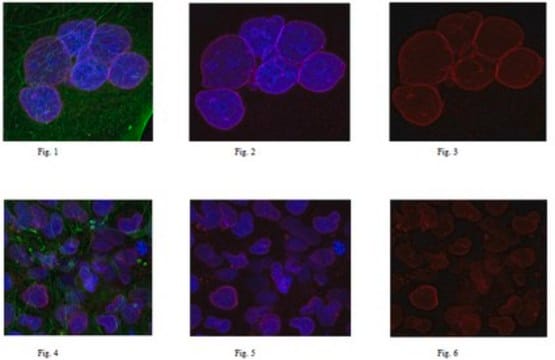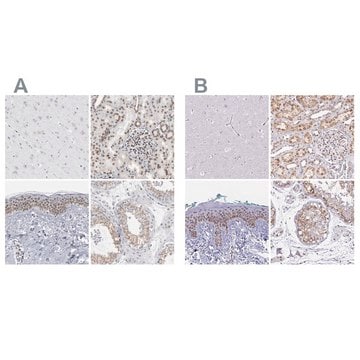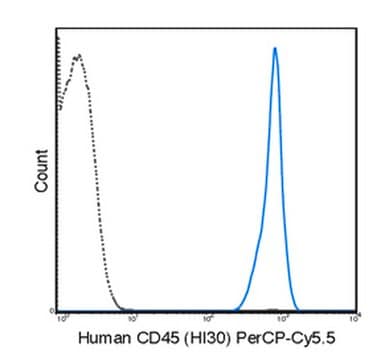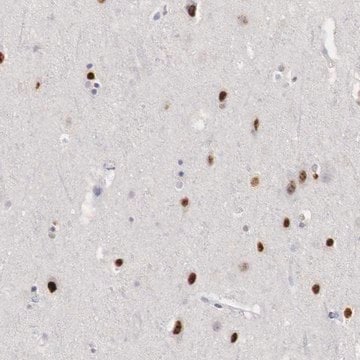MABN857
Anti-SYNE1 Antibody, clone 200A6
clone 200A6, from mouse
Synonyme(s) :
CPG2, Enaptin, Enaptin-165, Nesprin-1 Giant, Syne-1B
About This Item
Produits recommandés
Source biologique
mouse
Niveau de qualité
Forme d'anticorps
purified immunoglobulin
Type de produit anticorps
primary antibodies
Clone
200A6, monoclonal
Espèces réactives
rat
Réactivité de l'espèce (prédite par homologie)
mouse (based on 100% sequence homology)
Technique(s)
electron microscopy: suitable
immunocytochemistry: suitable
western blot: suitable
Isotype
IgG1κ
Numéro d'accès GenBank
Numéro d'accès NCBI
Conditions d'expédition
ambient
Modification post-traductionnelle de la cible
unmodified
Informations sur le gène
mouse ... Syne1(64009)
Description générale
Spécificité
Immunogène
Application
Electron Microscopy Analysis: A representative lot localized SYNE1 isoform CPG2 immunoreactivity colocalized with clathrin in the postsynaptic endocytic zone by immunoEM labeling of 60 nm thick serial sections of 4% paraformaldehyde-/0.1% glutaraldehyde-fixed rat neurons (Cottrell, J.R., et al. (2004). Neuron. 44(4):677-690).
Immunocytochemistry Analysis: A representative lot immunolocalized SYNE1 spliced isoform CPG2 on the dendritic spines, colocalized with clathrin, but segregated from the PSD and actin filaments in the spine head, by fluorescent immunocytochemistry staining of 4% formaldehyde-fixed, 0.3% Triton X-100-permeabilized rat hippocampal neurons. Target staining was greatly diminished among neurons received cellular CPG2 shRNA delivery (Cottrell, J.R., et al. (2004). Neuron. 44(4):677-690).
Western Blotting Analysis: A representative lot detected SYNE1 spliced isoform CPG2 as a ~110 kDa boublet band in rat cerebral cortex tissue extract and lysate from isolated rat cortical neurons. Target band detection was greatly diminished when using lysate from neurons following cellular CPG2 shRNA delivery (Cottrell, J.R., et al. (2004). Neuron. 44(4):677-690).
Neuroscience
Qualité
Western Blotting Analysis: 4 µg/mL of this antibody detected the ~110 kDa SYNE1 spliced isoform CPG2 in 10 µg of rat hippocampus tissue lysate.
Description de la cible
Forme physique
Stockage et stabilité
Autres remarques
Informations légales
Clause de non-responsabilité
Not finding the right product?
Try our Outil de sélection de produits.
Code de la classe de stockage
12 - Non Combustible Liquids
Classe de danger pour l'eau (WGK)
WGK 1
Point d'éclair (°F)
Not applicable
Point d'éclair (°C)
Not applicable
Certificats d'analyse (COA)
Recherchez un Certificats d'analyse (COA) en saisissant le numéro de lot du produit. Les numéros de lot figurent sur l'étiquette du produit après les mots "Lot" ou "Batch".
Déjà en possession de ce produit ?
Retrouvez la documentation relative aux produits que vous avez récemment achetés dans la Bibliothèque de documents.
Notre équipe de scientifiques dispose d'une expérience dans tous les secteurs de la recherche, notamment en sciences de la vie, science des matériaux, synthèse chimique, chromatographie, analyse et dans de nombreux autres domaines..
Contacter notre Service technique








